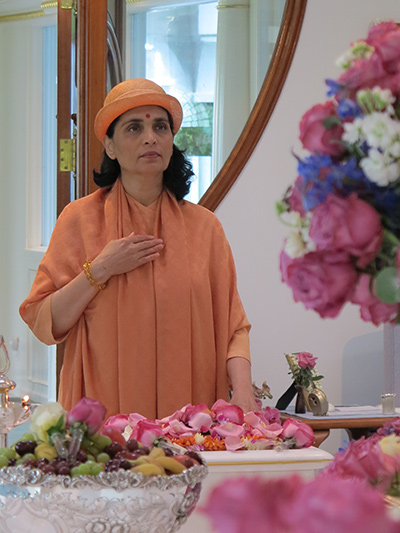Kṛpā kā Jharanā
The Waterfall of Grace
Part IX
An Account of the Gurupurnima Celebration Satsang
with Gurumayi Chidvilasananda
Shree Muktananda Ashram and Gurudev Siddha Peeth
Saturday, July 12, 2014
by Swami Ishwarananda and Ami Bansal
In Shree Muktananda Ashram, after the satsang via audio connection concluded, Gurumayi went for Bade Baba’s darshan.
What a divine moment. We were cloaked in the luminous rays of grace. Then Gurumayi requested that Swami Akhandananda wave her āratī lamp, which had been placed before Bade Baba during the satsang. She explained that the final ritual at the conclusion of a pūjā or a yajña includes the waving of lighted camphor before the deity, the Guru, or the sacred fire.
Viju Kulkarni, a Siddha Yoga musician, led everyone in singing the ancient Vedic verses that are recited at the culmination of a significant pūjā or auspicious occasion.
The verses in praise of Lord Shiva, the primordial Guru, say:
karpūragauraṁ karuṇāvatāraṁ
saṁsāra-sāraṁ bhujagendra-hāram
sadā vasantaṁ hṛdayāravinde
bhavaṁ bhavānī-sahitaṁ namāmi
White as camphor, wearing the lord of serpents as his necklace, he is the incarnation of compassion and the essence of the universe. I bow to that Shiva who, with Pārvatī, always dwells in the lotus of the Heart.
karpūrapūreṇa manohareṇa,
suvarṇapātrodaka-saṁsthitena
pradīptavāsā-sahasaṁgatena
nīrājanaṁ te jagadīśa kurve
O Lord of the universe, I wave before you the most brilliant camphor lamp, which is placed in a golden lamp-holder placed in the middle of a tray containing water.
The white color of camphor indicates purity and the capacity to purify. As camphor burns, it gives off light and its purifying fragrance becomes one with the atmosphere. In this way it represents divine union—the burning away of the limited ego in the fire of devotion and becoming one with the Divine.
After the āratī lamp is waved to the Guru or deity, one comes forward and places the palms of one’s hands over the lamp to receive its purifying warmth. One then touches one’s warm hands to the head, eyes, and heart, so that the blessings of the āratī are received by one’s entire being.
Therefore, at the conclusion of the final āratī in the Bhagavan Nityananda Temple, Gurumayi invited each participant to come forward and receive the blessing of the fragrant smoke from the camphor that had been offered to Bade Baba.
On the Siddha Yoga path website, all the teachings during the month of July have been focused on the meaning and importance of the celebration of Gurupurnima. For example: Teachings on the Guru Principle, the stories of the “Origins of Gurupurnima” and “Nizāmuddīn and Amīr Khusro,” the Gurupurnima dhāraṇā, theShri Guru Pādukā Pancakam, the Exposition on Dakshiṇā, andShri Gurujñāna. Reading these beautiful teachings has supported us in understanding, preparing for, and continuing to go deeper into the meaning of this celebration. With this knowledge we are able to experience Gurumayi’s prasād to the fullest. It is the union of sacred knowledge and divine experience.
With all our hearts, on behalf of every Siddha Yogi and new seeker who has participated in this satsang, and who will participate through the Siddha Yoga path website, we give thanks to our beloved Shri Gurumayi.
We give thanks to Gurumayi ji for celebrating Gurupurnima with us in this historic way, bringing the ancient tradition of Gurupurnima alive before our eyes and in our minds and hearts.
We offer gratitude to Gurumayi ji for the extraordinary love she has bestowed on us––a love that has flowed from this satsang out to the hearts of every Siddha Yogi and new seeker.
We are thankful to Gurumayi ji for her anukampā—her benevolence, compassion, and grace—which invite all of us into her divine world.
We ardently aspire to abide by Gurumayi’s command given on Gurupurnima:
“Be your own best friend.”
With this celebration we renew our commitment to live our lives in service to Gurumayi ji and the Siddha Yoga path.

With great reverence and love we offer infinite pranamsat the lotus feet of Shri Gurumayi.
Once again, Shubh Gurupurnima!





